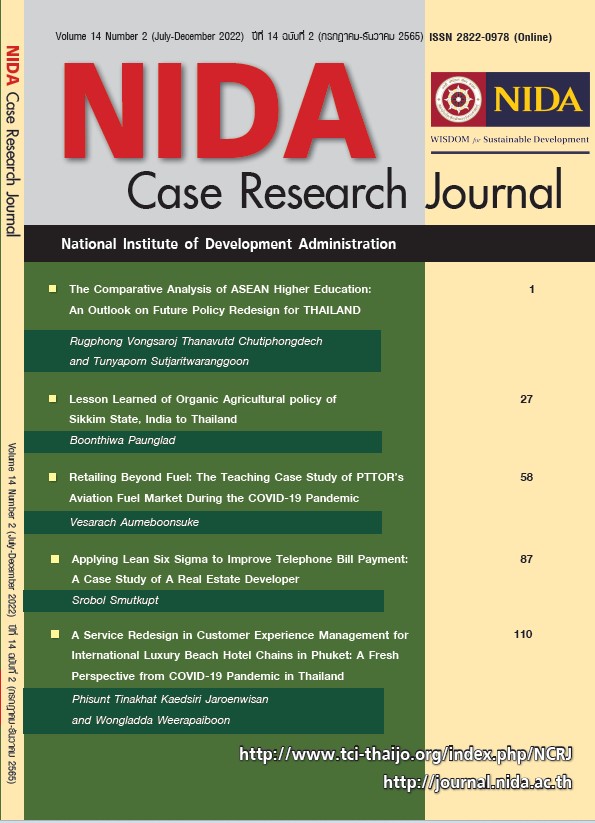Applying Lean Six Sigma to Improve Telephone Bill Payment: A Case Study of A Real Estate Developer
DOI:
https://doi.org/10.14456/ncrj.2022.4Keywords:
DMAIC, FMEA, Lean Six Sigma, Payment Process, Process ImprovementAbstract
This case study is about deploying Lean Six Sigma methodology to improve performance as well as assist in developing improvement practices in organizations. The objectives of this study are to focus on process efficiency and to ensure that the payment lead time is within the due date. The steps have been taken through systematic thinking, including DMAIC, and by utilizing Lean tools to streamline the process. The Six Sigma methodology uses data and facts to identify the root causes of the problem, while the Lean method eliminates wastes and non-value-added steps. Process Flow, Fishbone Diagram, and Failure Mode and Effects Analysis (FMEA) are utilized to confirm causes and provide potential improvement actions. In the end, the accounting staff reduced the workload in handling the telephone bill payments from five days to two days per month. The administrative staff and the management have spent less time dealing with all the telephone invoices. This was done by eliminating some non-value-added steps. Moreover, the payment lead time can be processed on time with accuracy.
References
Antony, J. (2012). A SWOT analysis on Six Sigma: some perspectives from leading academics and practitioners. International Journal of Productivity and Performance Management, 61(6), 691-698.
Appollis, L.M., van Dyk, W.A. & Matope, S. (2020). Using Failure Modes and Effects Analysis As A Problem-Solving Guideline When Implementing SPC in A South African Chemical Manufacturing Company. South African Journal of Industrial Engineering, 31(1), 157-169.
Aummontha, W. & Smutkupt, S. (2017). Business process improvement of customer service for an eBay jewelry company. Journal of Supply Chain Management: Research & Practice, 11(2), 39-55.
Bowersox, D.J., Closs, D.J. & Cooper M. B. (2010). Supply Chain Logistics Management, McGraw-Hill, New York.
Breyfogle III, F.W. (1999). Implementing Six Sigma Smarter Solutions Using Statistical Methods.
John Wiley & Sons, Inc. New York.
Burch V, R.F., Strawderman, L. & Bullington, S. (2016). Global corporation rollout of ruggedised handheld devices: a Lean Six Sigma case study. Total Quality Management, 27(1), 1-16.
Chahal, V. & Narwal, M.S. (2017). An empirical review of lean manufacturing and their strategies. Management Science Letters, 7, 321-336.
Furterer, S. & Elshennawy, A. K. (2005). Implementation of TQM and Lean Six Sigma Tools in Local Government: a Framework and a Case Study. Total Quality Management, 16(10), 1179-1191.
Gijo, E.V., Antony, J. & Sunder, V.M. (2019). Application of Lean Six Sigma in IT support services – a case study. The TQM Journal, 31(3), 417-435.
Harry, M. & Schroeder, R. (2000). Six Sigma The Breakthrough Management Strategy Revolutionizing the World’s Top Corporations. Doubleday, New York.
Kuaites, T.,Thueanphae, T. & Chanthranapasawat, N. (2020). The Application of Lean Concept to Waste Reduction of Working Process in Hotel Service Industry. IEEE 7th International Conference on Industrial Engineering and Applications, 1070-1075.
Kuvvetli, Ü. & Firuzan, A. R. (2019). Applying Six Sigma in urban public transportation to reduce traffic accidents involving municipality buses. Total Quality Management, 30(1), 82-107.
Langley, C.J,, Coyle, J.J., Gibson, B.J., Novack, R.A. & Bardi, E.J.(2008). Managing Supply Chains: A Logistics Approach. South-Western Cengage Learning.
Lee, K., Tai, C. & Sheen, G. (2013). Using LSS to improve the efficiency and quality of a refund process in a logistics center. International Journal of Six Sigma, 4(4), 409-424.
Milena, S & Arvilla, C. (2014). Risk Assessment in Project Planning Using FMEA and Critical Path Method. Scientific Papers Series Management, Economic Engineering in Agriculture and Rural Development, 14(30), 39-45.
Salmon, E.M. (2017). Lean Six Sigma Case Study within a Public School District. American
Society for Engineering Education. Proceedings of the ASEE Annual Conference & Exposition, 2017, 15995-16010.
Sangphang, P., Smutkupt, S. & Pjongluck, D. (2020). The Improvement of Stock Allocation Lead Time by Using Lean Six Sigma. Journal of Supply Chain Management: Research & Practice, 14(2), 39-45.
Schroeder, R. D, Linderman, K., Liedtke, C. & Choo, A. S. (2008). Six Sigma: Definition and Underlying theory. Journal of Operations Management, 26, 536-554.
Sheila, S. & Shahbaz, S. (2012). The McGraw-Hill 36-Hour Course: Lean Six Sigma, McGraw Hill.
Smutkupt, S. & Narathornsawatdikul, U. (2019). An Improvement of Delivery Lead Time: A Case Study of a Trading Company. Humanities, Arts and Social Sciences Studies, 19(3), 616 627.
Snee, R.D. (2010). Lean Six Sigma – getting better all the time. International Journal of Lean Six Sigma, 1(1), 9-29.
Villareal, B., Garza, F., Rosas, I. & Garcia, D. (2012). An Introduction to Distribution Operational Efficiency. International Journal of Industrial Engineering, 19(7), 278-288.
Downloads
Published
How to Cite
Issue
Section
License

This work is licensed under a Creative Commons Attribution-NonCommercial-NoDerivatives 4.0 International License.





